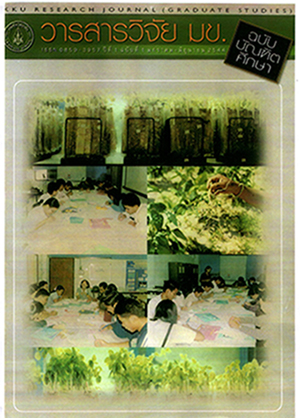Effects of Dried Brewers Grains as Replacement for concentrate in the Ration of Lactating Dairy Cattle (ผลของกากเบียร์แห้งทดแทนอาหารข้นในอาหารของโคนม)
Keywords:
Dried brewers grain, Dairy cattle, Milk productionAbstract
This experiment was carried out to study the effect of optimal levels of dried brewers grains replacement for concentrate in dairy ration on production performance of dairy cows. Eight, 75% crossbred Holstein Friesian cows, with averaged 370(+,ฑ)79 kg live weight, 78(+,ฑ)25 days in milk, were arranged according to replicated 4x4 Latin square design and allotted to receive one of four dietary treatments in which dried brewers grain (DBG) (26.4% crude protein (CP)) replacement for concentrate (14%CP) at 0 (control), 10, 20, and 30%. Cows were offered urea-treated rice straw (UTS) (7.5%CP) as roughage source ad libitum. Concentrate was offered according to concentrate to milk production ratio at 1:2. Four experimental periods were employed and each period lasted for 21 days. The results of the experiment revealed that total dry matter intake expressed as % live weight (LW) (2.91, 2.90. 3.00. and 3.09%) and as g/kgW(0.75) (127.5, 127.0, 131.2, and 135.6 g/kgW(0.75) were significantly different (p<0.05) and linearly increased (p<0.03) as DBG increased. Intake of organic matter (OM), gross energy (GE) and digestible organic matter intakes (DOMI) were not significantly different (p>0.05) among dietary treatments but crude protein (CP) intake (1.07, 1.14, 1.24 and 1.33 kg/d) was linearly increased (p<0.01) as levels of DBG increased. Digestion coefficients of dry matter (DM), OM, CP, acid detergent fiber (ADS) and GR were not significantly different among dietary treatments (p>0.05). Ruminal PH, ammonia nitrogen (NH(,3)-N) and blood urea nitrogen concentrations were not significantly different (p>0.05), but total volatile fatty acid (TVFA) decreased at the high levels of DBG, (p>0.05). However, acetic acid (C(,2)) concentration was linearly increased (p<0.05) (67.7, 71.8, 72.1, and 72.5 mot /100 mol) while propionic acid (C(,3)) concentration was linearly decreased (p <0.05) (24.2, 21.0, 21.3, and 19.8 mol/ 100 mol) when DBG replaced levels of concentrate. Milk production (8.61, 8.87, 9.26 and 9.33 kg/d), and 3.5% fat corrected milk (FCM)(8.54,8.73,9.41 and 8.86 kg/d) were not significantly different (P>0.05) milk (FCM) (8.54 ,8.73, 9.41 and 8.86 kg/d) were not significantly different (P>0.05) among dietary treatments, but milk protein productions (0.25, 0.25, 0.28, and 0.31 kg/d) were linearly increased (p<0.02) as levels of DBG replacement for concentrate were increased.Downloads
Additional Files
Published
2015-02-12
Issue
Section
วิทยาศาสตร์ชีวภาพ



